Picto Diary - 09 June 2017 - Dawson City, YT
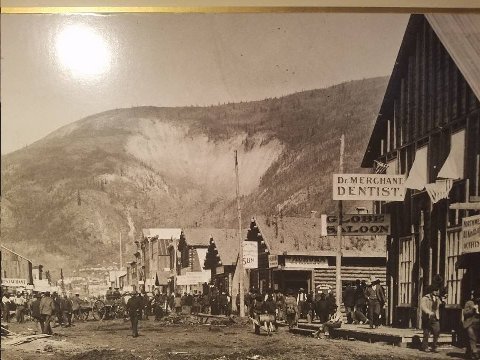
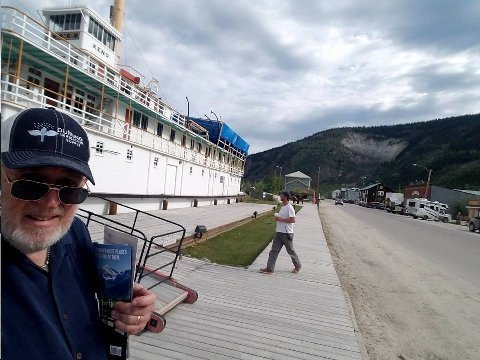
Above: Two images. Front Street, Dawson City, YT. The first, 1898. The second, 09 June 2017.
The only common denominator of the two images is the mountain scar on the mountain called "The Dome."
On first glance I thought the scar derived from the mining days where sand or dirt was quarried for construction purposes. Silly me. The scar is from a landslide from pre historic times.
Dawson sits on the Tintina fault. As I mentioned in yesterday's post about the Tintina Trench, this area has been rife with landslides for centuries. And, gold and other minerals are often found in abundance along fault lines.
As I look at the first image, I try to imagine the scene here one hundred twenty years ago. I have a little understanding of what it takes to get here by land, having ridden up - now 3500 miles and counting - on the F800GS motorcycle. But, the ordeal of steaming up to Skagway from San Francisco, hiking up from Skagway over the White Pass, and then floating 400 plus miles down the Yukon River with over 1000 pounds of stuff per individual, really makes my motorcycle ride seem like a trifle. How times have changed.
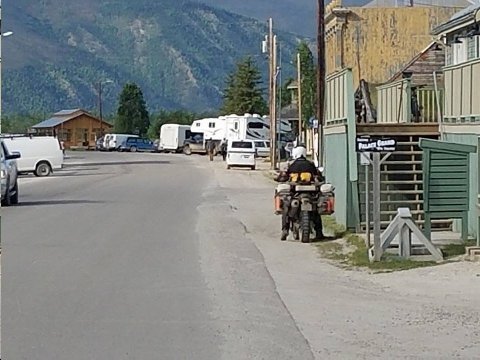
Above: Alan, riding BMW R1200 GS, on Front Street. Dawson, YT. 09 June 2017.
Alan, about 65, is from Victoria, Oz. He was riding his own bike. He started in Seattle three weeks ago. He's on a five month long ride throughout North America. Like me, he plans on riding the Top of the World Highway - destination Tok, Alaska - while he's up here. He's camping throughout his journey.
Riding alone, and so far away, and contemplating a ride on such an obscure road as "Top of the World," one thinks about teaming up when he meets another solitary rider.
But, teaming up is a double edge sword. Different riders have different riding abilities and styles... different ideas about where to stop... how far to ride in one stage. Riding solitary provides a lot of flexibility. You can stop or start when and where you want. When you are curious about something along the side of the road, or see a specific image you want to capture, you can do it without wondering whether or not you are going to screw up your partnership with another (other) rider (s).
"Top of the World Highway," as obscure as it is... has a far amount of traffic including RV's and even busses on tour from as far away as Anchorage... 400 miles from Dawson.
So... though teaming up could be considered... neither Alan nor I raised the prospect.
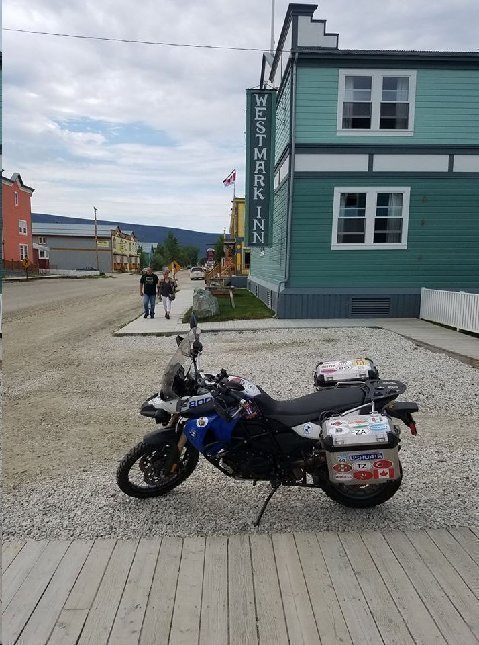
Above: My BMW F800GS motorcycle parked at Westmark Inn, Dawson City, YT. 09 June 2017.
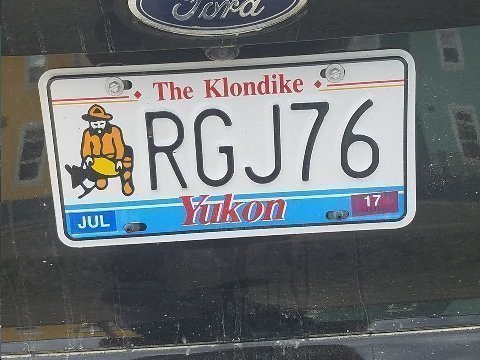
Above: Yukon tag. Dawson City, YT. 09 June 2017.
Gold mining theme.
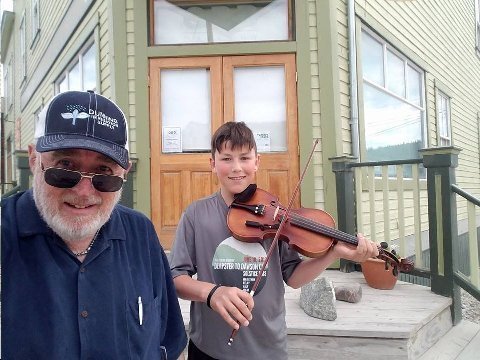
Bishop and Noah. Dawson, YT. 09 June 2017.
Prepubescent musician on the street playing, for tips, 1890's period dance hall tunes.
What an imaginative concept... and a good way for a young kid to make extra money.
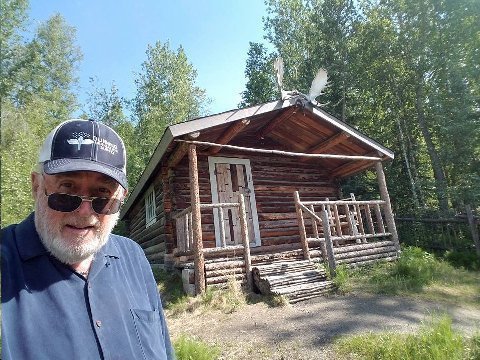
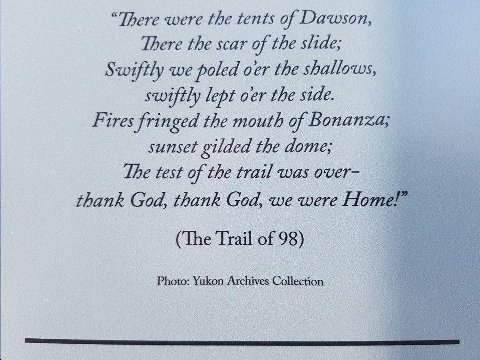
Above: Bishop Robert Service cabin. Dawson, YT. 9 June 2017.
Robert W. Service, "The Bard of the Yukon," a British/Canadian, lived and wrote in this cabin from 1909 to 1912.
Service was the most prolific poet and best selling writer of the 20th century.
Service's best known works are "The Shooting of Dan McGraw," and "The Cremation of Sam McGee."
Interestingly, Service didn't make it to Dawson until 1909, ten years after the peak of the gold rush. But, he spent the previous fifteen years in the western United States and western Canada. He was a bank clerk in Kamloops, BC before he was transferred to Whitehorse, YT in 1907. He knew the old Klondike miners and so he knew the lore. He was impelled to write about those heady days in 1898 before actually living in Dawson at this cabin ten years later.
The brief verse shown on the accompanying image, "The Trail of '98" captures lyrically, in few words, the thrill of reaching "home... Dawson," in 1898, after such an arduous journey. Reading these lines I can understand how Service's economic poetic style caught the imagination of the English speaking public.
Five years ago, TIMDT, our kids families, and Mwah (sic) stopped at Skagway while on an Alaskan cruise. We took the White Pass Railway to the top of the White Pass, then recognizing, only, dimly that the pass had something to do (pre railway) with the 1898 Klondike gold rush.
This motorcycle trip to Dawson has helped me fill in a lot of the blanks in my mind that I had then regarding the great Klondike gold rush.
In 1898, the gold seekers, having arrived in Skagway by steam boat from Seattle and San Francisco, had to climb White Pass (Chilkoot Trail) carrying with them the thousand pounds of gear and food required of them by the Canadian government. They hired horses and mules at exorbitant prices only to find many of the animals perished in the severe cold.
When the would-be miners reached the top of the pass they had to make their way... not too far... to the headwaters of the Yukon River. I rode the F800FS through this Yukon head waters area day before yesterday, to Whitehorse, YT. There they would craft boats, rafts, whatever they could make float, and "sail" down the Yukon, through the Whitehorse rapids, to Dawson. Many gold seekers were killed running the Whitehorse rapids. I visited the site of the rapids, now a smooth flowing water course backed up by a dam built in 1959, two days ago.
From Whitehorse, I rode the motorcycle to the miner's final destination, Dawson City, yesterday. I saw another rapids obstacle along the way: Five Finger Rapids.
One can imagine how these exhausted travelers exulted arriving in Dawson after such an arduous journey. The journey was adventuresome enough for me riding a motorcycle. I marvel at someone on the same quest one hundred twenty years ago.
But, note how beautifully Service' short verse captures how the travelers must have felt at journey's end.
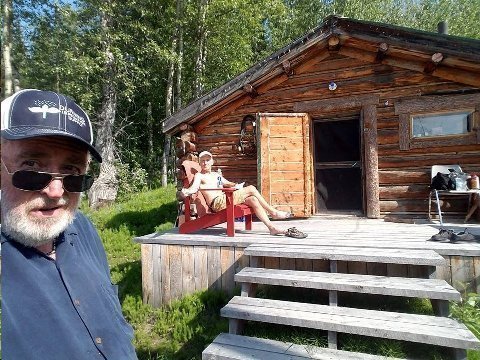
Addendum:
Had to look up YT...Yukon Territory! Not something we hear often on the east coast!
Bronx Girl, Pelham, NY
HI Steve! Thanks for your wonderful descriptions of the Klondike Trail.
When I grew up in Nashville a few decades ago, we had to learn by heart a number of poems in Junior High School. All the poems had messages for young kids about life. (I don’t find that many curriculums include such today!) I will not likely make the Klondike now but I had to memorize "The Cremation of Sam Mcgee” , probably because he was from Tennessee. (And then there was “Little Giffen of Tennessee, eighteenth battle and he sixteen, smitten with grapeshot and gangrene” — nothing to do with the Klondike, but part of lessons to be learned for a kid in the South.) I devoured Robert Service stuff but when I had to stand up in front of a class I chose part of “Spartacus to the Gladiators”. I still remember this and even declaimed it to 4th graders in Mike Jorgenson’s class for TGE in Heber a few months ago when I gave my talk on a late teenager called to work on the atom bomb —— Regards,
Manhattan,
Park City, UT
Apt (and appreciated) comment considering today's posting.